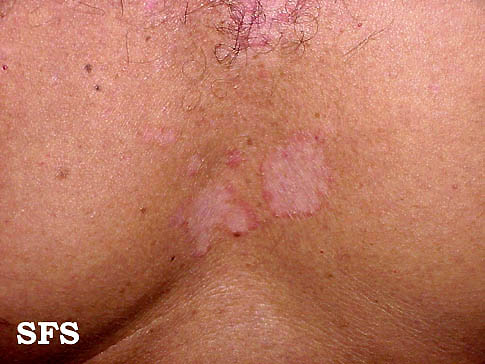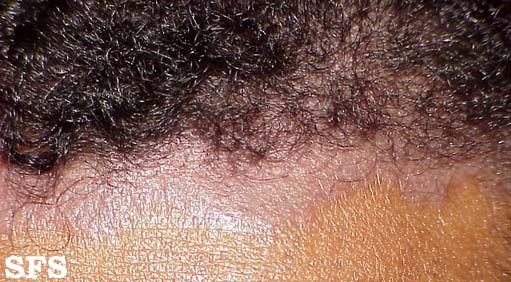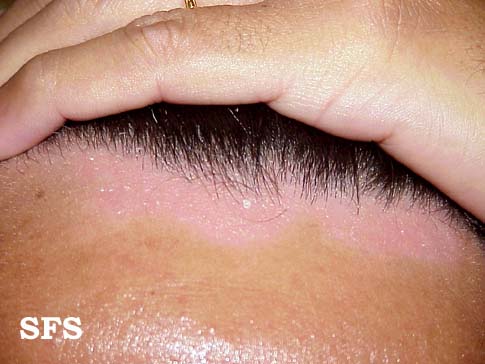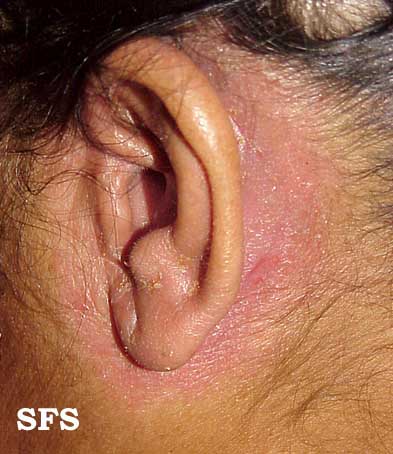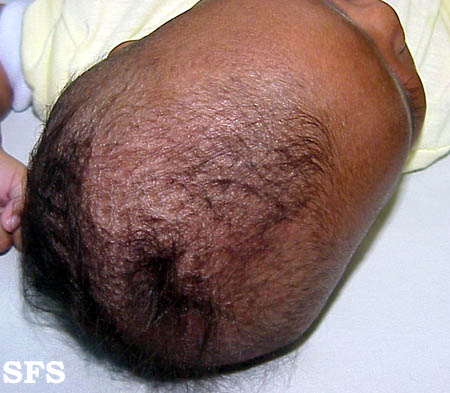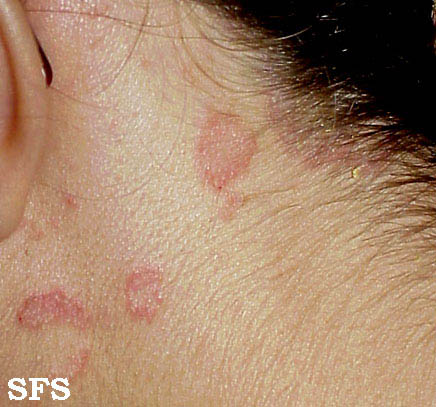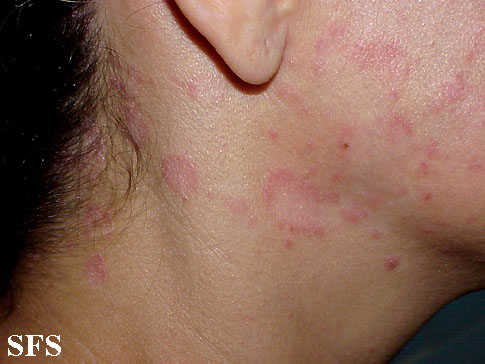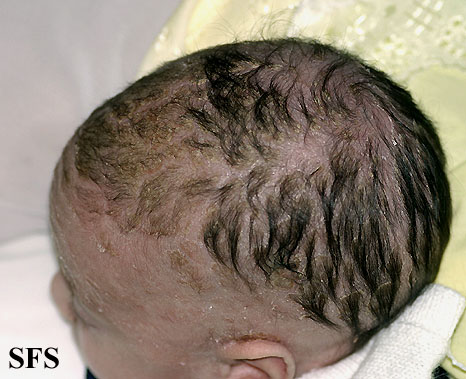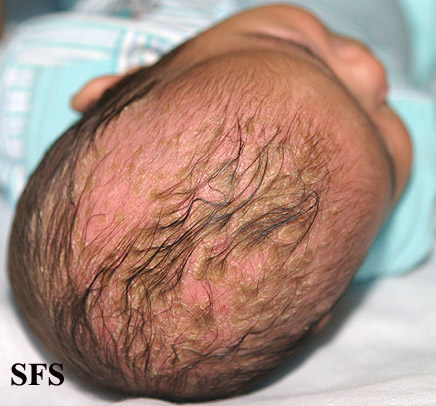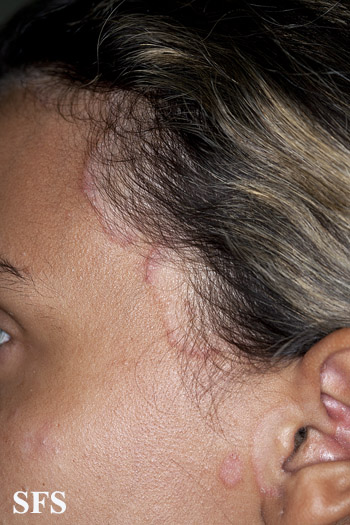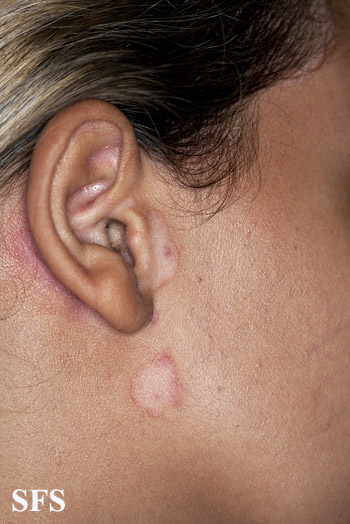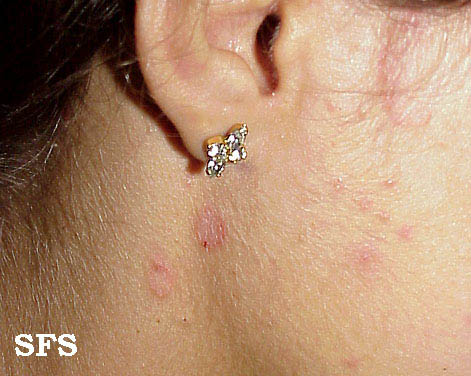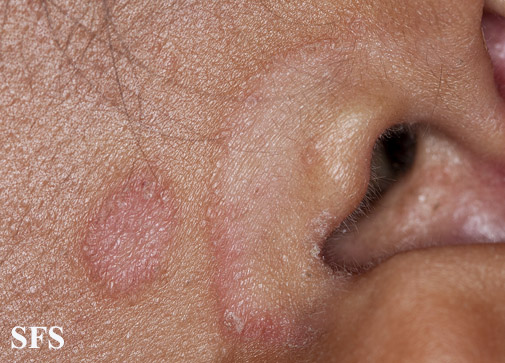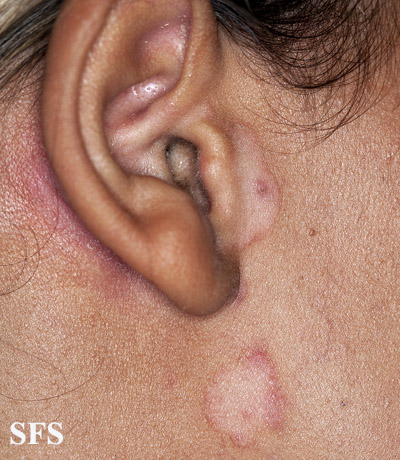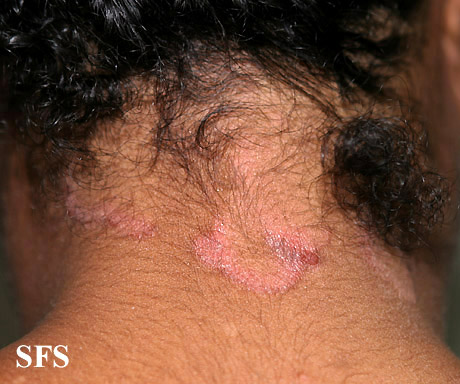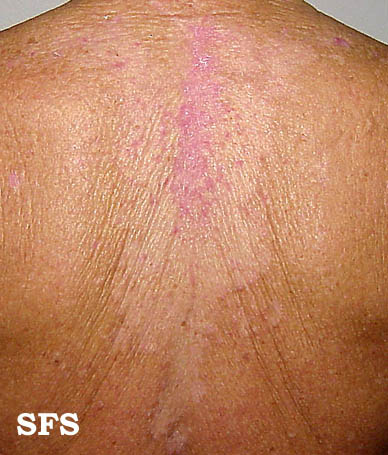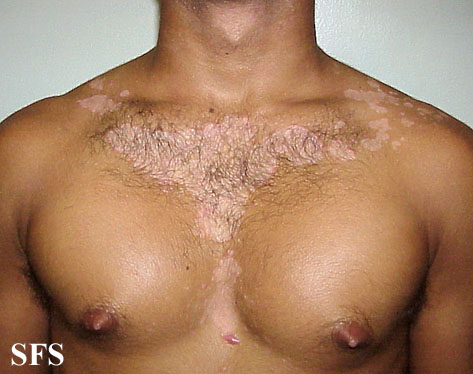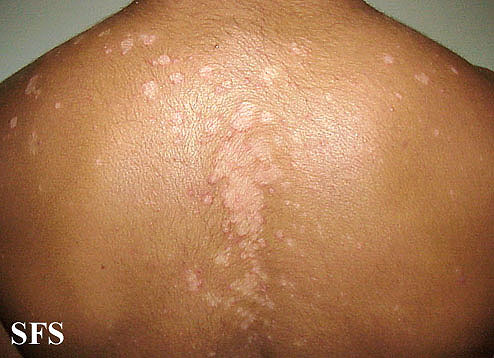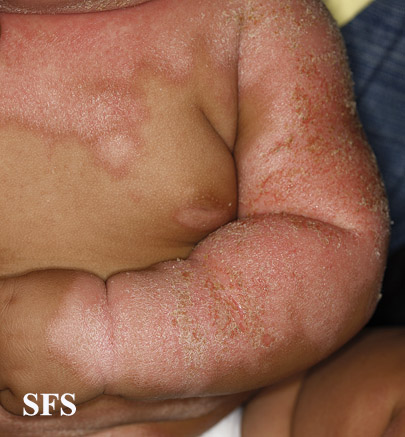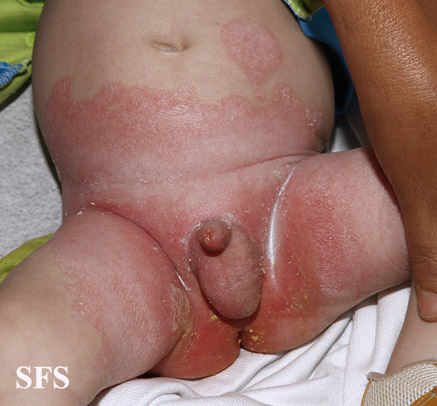Seborrheic dermatitis: Difference between revisions
Aysha Aslam (talk | contribs) |
Aysha Aslam (talk | contribs) |
||
| Line 132: | Line 132: | ||
==== Incidence ==== | ==== Incidence ==== | ||
Seborrheic dermatitis has a biphasic incidence, which involves occurence in infants between age range of 2-12 weeks and second incidence peak occuring later in life during adulthood between age groups of 40 to 60 years of life.<ref>Denton, C. P., et al. "Scleroderma (systemic sclerosis)." Fitzpatrick’s Dermatology in General Medicine. 7th ed. New York, NY: McGraw-Hill Medical Publishing Division (2008): 1553-1562</ref>. Incidence of seborrheic dermatitis is affected by the following factors: | Seborrheic dermatitis has a biphasic incidence, which involves occurence in infants between age range of 2-12 weeks and second incidence peak occuring later in life during adulthood between age groups of 40 to 60 years of life.<ref>Denton, C. P., et al. "Scleroderma (systemic sclerosis)." Fitzpatrick’s Dermatology in General Medicine. 7th ed. New York, NY: McGraw-Hill Medical Publishing Division (2008): 1553-1562</ref>. Incidence of seborrheic dermatitis is affected by the following factors: | ||
*The incidence of seborrheic dermatitis is higher in patients with HIV with | *The incidence of seborrheic dermatitis is higher in patients with HIV with 35000 per 100,000 in early diagnosis and 85000 per 100,000 with full blown AIDS.<ref name="pmid14678527">{{cite journal| author=Gupta AK, Bluhm R| title=Seborrheic dermatitis. | journal=J Eur Acad Dermatol Venereol | year= 2004 | volume= 18 | issue= 1 | pages= 13-26; quiz 19-20 | pmid=14678527 | doi= | pmc= | url=http://www.ncbi.nlm.nih.gov/entrez/eutils/elink.fcgi?dbfrom=pubmed&tool=sumsearch.org/cite&retmode=ref&cmd=prlinks&id=14678527 }} </ref><ref name="pmid3100109">{{cite journal| author=Okochi T, Seike H, Saeki K, Sumikawa K, Yamamoto T, Higashino K| title=A novel alkaline phosphatase isozyme in human adipose tissue. | journal=Clin Chim Acta | year= 1987 | volume= 162 | issue= 1 | pages= 19-27 | pmid=3100109 | doi= | pmc= | url=http://www.ncbi.nlm.nih.gov/entrez/eutils/elink.fcgi?dbfrom=pubmed&tool=sumsearch.org/cite&retmode=ref&cmd=prlinks&id=3100109 }} </ref> | ||
===Demographics=== | ===Demographics=== | ||
Revision as of 18:03, 16 August 2016
Editor-In-Chief: C. Michael Gibson, M.S., M.D. [1]; Associate Editor(s)-in-Chief: Jesus Rosario Hernandez, M.D. [2]; Aysha Anwar, M.B.B.S[3]
Synonyms and keywords: Seborrheic eczema
Overview
Seborrhoeic eczema (also known as Seborrheic dermatitis AmE, seborrhea) is a skin disorder affecting the scalp, face, and trunk. Seborrhoeic dermatitis causes flaky, itchy, red skin and temporary hair loss. It particularly affects the sebum-gland rich areas of skin. Causes of seborrhoeic dermatitis include Malassezia furfur (formerly known as Pityrosporum ovale), as well as genetic, environmental, hormonal, and immune-system factors. Medical therapy for seborrhoeic dermatitis includes antifungal agents, corticosteroids, and lithium salts.
Historical Perspective
Classification
There is no established classification system for seborrheic dermatitis.However, seborrheic dermatitis can be classified on the basis of following factors:[1][2][3][4]
- Localised
- Scalp: In infants its called Cradle Cap. Its the most common presentation in infants and appear as red yellow plaques coated by thick greasy scales, commonly appearing in first three months of age.In adults, presentation of disease is mild desquamation to honey coloured crusts which can extend to involve forehead called "corona seborrheica"
- Face: It most commonly involves eyelids, eyebrows and nasolabial folds. Eyes are involved resulting in blephritis.
- Retroauricular: lt invloves crusting, oozing and fissuring in the affected area. It may also involve external ear resulting in otitis externa.
- Body folds: It usually affects axilla, breast folds, inguinal area and genital area. May progress to fissuring and secondary infection.
- Upper Chest: It is mostly seen in adults. Affected areas may present with one of the following presentation.
- Pityriasiform: It is usually in the form oval macules and patches ranging from 5-15mm in size which tend to involve intertriginous areas.
- Petaloid type: It appears as small papules with oily scales which enlarges to become patches giving it an appearance of petals of flower, hence the name.
- Trunk: common in infants and most common site of involvement is lower abdomen.
- Generalized: mostly seen in infants associated with leiner's disease and children with severe immunodeficiency. It usually is associated with diarrhea and failure to thrive and may resolve in few weeks.
Classification by Age
- Infantile: seen in first three months of life. It is mostly a self limited disease in children.
- Adults: occurs most commonly between 30-60 years of age. In adults, it usually appears as chronic relapsing condition invloving various parts of the body.
Classification by Symptomic Presentation
- Non pruritic: This type is most commonly seen in infants.
- Pruritic: This type is seen in older children and adults. This type is common with scalp involvement.
Classification by Etiology
Exact cause of seborrheic dermatitis is unknown.However, following causes may be related to pathogenesis of seborrheic dermatitis.
- Idiopathic : No known cause
- Infectious: Caused by fungus named Malssezia based on its response to antifungal agents.
- Autoimmune/Inflammatory:One hypothesis suggests it as a primary inflammatory dermatoses resulting in increased apoptosis, scaling and inflammation in epidermis[[.
Classification by Severity
- Mild to moderate disease: seen in immunocompetent individuals.
- Severe disease: Immunocomprised patients have more extensive disease which is mostly unresponsive to treatment.
Pathophysiology
Complete pathogenesis of seborrheic dermatitis is not fully understood. However, studies have demonstrated strong correlation between presence of fungal yeast named Malasezia and seborrheic dermatitis.[5] Malasezia is a lipophilic yeast found on the skin of both healthy individuals and seborrheic dermatitis patients. The exact mechanism of disease process in individuals having seborrheic dermatitis is not established but it is thought that host reaction to Malasezia or its metabolites causing inflammatory reaction may have a significant role in the process. Two species of Malasezia named Malasezia globosa and Malasezia restricta may have a stronger association with the development of seborrheic dermatitis.[6]. Another proposed mechanism for seborrheic dermatitis may indicate that lipid layer of fungus Malassezia when disrupted leads to an inflammatory response resulting in increased production of pro inflammatory cytokines such as IL-6 and IL-7 and decreased production of IL-10. [7] However, there is no genetic predisposition for seborrheic dermatiti
Gross Pathology
Superficial flaking and redness are characteristic findings of seborrheic dermatitis. Flakes usually occur in patches on scalp and tend to move about scalp over time.[8]
Microscopic Histopathology
Histopathological findings of seborrheic dermatitis can be divided into three types based on the following types, [9][10]
Acute
Focal mild spongiosis with superficial crust containing neutrophils centered on a follicle, mild Edema of papillary dermis, dilatatiuon of blood vessels in superficial vascular plexus with mild infiltration of lymphocytes, histiocytes and occasional neutrophils are characteristic findings of seborrheic dermatitis.
Subacute
In addition to findings mentioned above, there is also some psoriasiform hyperplasia in subacute form of seborrheic dermatitis. This type may show presence of yeast like organisms in the surface keratin.
Chronic
Extensive psoriasiform hyperplasia and minimal spongiosis are characteristic findings seen in this type. This type resembles psoriasis and might be difficult to differentiate from psoriasis but presence of follicular crustiong favours seborrheic dermatitis.
Causes
The cause of seborrhoeic dermatitis remains unknown, although many factors have been implicated. The widely present yeast, Malassezia furfur (formerly known as Pityrosporum ovale), is involved,[11][12] as well as genetic, environmental, hormonal, and immune-system factors.[13][14] A suggestion that seborrhoeic dermatitis is an inflammatory response to this yeast has yet to be proven.[15] Those afflicted with seborrhoeic dermatitis have an unfavourable epidermic response to the infection, with the skin becoming inflamed and flaking.
In children, excessive vitamin A intake can cause seborrhoeic dermatitis.[16] Lack of biotin,[17] pyridoxine (vitamin B6)[17][18] and riboflavin (vitamin B2)[17] may also be a cause.
Differentiating Seborrheic dermatitis from Other Diseases
Differential diagnosis of seborrheic dermatitis can be classified into two types by age group[19]
Differential diagnosis in infants
- Atopic dermatitis
- [[Candidiasis]
- Dermatophytosis
- Diaper dermatitis
- Langerhans cell histiocytosis: It usually presents as refractory seborrheic dermatitis or diaper dermatitis in infants. Diagnosis is confirmed by skin biopsy.
- Psoriasis
Differential diagnosis in Adults
- Systemic lupus erytheramatosus[20]
- candidiasis
- Erythrasma
- Contact dermatitis
- Psoriasis[10]
- Tinea versicolor
- Tinea corporis
- Secondary syphilis
- Pemphigous foliaceous
- Roscacea
Epidemiology and Demographics
Epidemiology
Seborrheic dermatitis is one of the most common skin disorders in general population but prevalence estimate of the condition is difficult due to lack of diagnostic criteria and grading system for severity.[21]
Prevalence
Worldwide, the prevalence of seborrheic dermatitis is estimated to be 11000 cases per 100,000.[22] Prevalance rate varies among individuals based on the following factors:
- The prevalence rate of disease increases when mild cases are also involved.
- The prevalence of seborrheic dermatitis is higher in patients with HIV with 35000 per 100,000 in early diagnosis and 85000 per 100,000 with full blown AIDS.[23]The cause of increased prevalance in patients with seborrheic dermatitis is resistant to treatment.
- Regarding exposure to solar UV radiation, there is higher prevalence seen among those directly exposed to UV radiation which includes large percentage of mountain guides among general population.[24]
Incidence
Seborrheic dermatitis has a biphasic incidence, which involves occurence in infants between age range of 2-12 weeks and second incidence peak occuring later in life during adulthood between age groups of 40 to 60 years of life.[25]. Incidence of seborrheic dermatitis is affected by the following factors:
- The incidence of seborrheic dermatitis is higher in patients with HIV with 35000 per 100,000 in early diagnosis and 85000 per 100,000 with full blown AIDS.[23][26]
Demographics
Age
Seborrheic dermatitis commonly affects three age groups.[26][27][9]
- First incidence peak is seen in infants around three to four months of age, which usually resolves in 12 months
- Second incidence peak seen around puberty.
- Third incidence peak is seen after age 50 with highest prevalance seen among age group ranging 33-44 years of age.
- Age groups showing lowest prevalance of clinical disease is seen in individuals younger than 12 years.
Sex
Race
Risk Factors
Most common risk factors for Seborrheic dermatitis are[28][29]
- Immunocompromised Patients such as organ transplant recipients, patients with HIV, Hep C, chronic alcoholic pancreatitis and various malignancies such as lymphoma[30][31][32]
- Neurologic and psychiatric cases such as patients with Parkinsonism, patients with Depressive mood disorder, tardive dyskinesia, traumatic brain injury, epilepsy, facial nerve palsy, spinal cord injury
- Genetic disorders such as patients with Downs syndrome, Hailey Hailey disease, Cardiofaciocutaneous syndrome, mutation in (ZNF750) which codes for a zinc finger protein (C2H2) may be related to cause seborrhea like dermatitis
Other risk factors include
- Stress[33]
- Patients treated with psoralene and ultravoilet light A for psoriasis are seen to have a predisposition for seborrheic dermatitis.
- Male population is more prone to develop seborrheic dermatitis as compared to females.[34]
- Obesity, Diabetes Mellitus and other endocrine disorders causing alteration in glucose metabolism.[35]
- Seasonal changes such as low temperature and decreased humditiy may have a significant role in seborrheic dermatitis flare ups[36]
- Drugs such as haloperidol deconate, lithium and chlorpromazine are associated with increased risk of disease in some patients.
Screening
Natural History, Complications, and Prognosis
Natural History
Complications
- Side effects to inflammation may include temporary hair loss. If severe outbreaks go untreated for long periods of time, permanent hair loss may result due to damaged hair follicles.
- Secondary bacterial infection may occur aggravating erythema, exudate and increase in local discomfort.
- Blephritis involving meibomian glands can cause abcess formation.
- Otitis Externa can result from involvement of external ear due to maceration of skin due to extcessive itching.
- Severe seborrheic dermatitis or generalised seborrheic erythroderma can occur with immunosuppression including HIV or cardiac failure.
Prognosis
- Prognosis of Seborrheic dermatitis is excellent in infants as it is a self limited disease and usually resolves in few months after birth. However, in adults it is a recurrent condition with no permanant cure. In conditions where patient is immunocompromised such as HIV or malignancy it is refractory to treatment.
Diagnosis
Diagnostic Criteria
There are no definitive diagnostic criteria for seborrheic dermatitis.
History and Symptoms
Obtaining complete history is important in making diagnosis of seborrheic dermatitis as it will give an insight into cause and associated risk factors for the disease. In addition to symptoms of seborrheic dermatitis presence of any of the following conditions are suggestive of below mentioned etiologies
- Parkinsons disease
- Epilepsy
- Depressive mood disorder
- Traumatic brain injury
- Spinal cord injury
- HIV
- Lymphoma
- Downs Syndrome
- Hailey Hailey Disease
- Diabetes Mellitus
Symptoms
Symtoms can be divided into following categories based on age:
Infants
Infants usually present in the first three months of life with following symptoms
- Thick greasy scales (Scalp-Cradle Cap)
- Redness (diaper area)
- Non pruritic
- Self limited
Adults
- Macules or thin plaques
- Erythema
- Yellow or whitish crusty scaling
- Swollen or greasy appearance
- Pruritis
- Blephritis
- otitis externa
Physical Examination
Head
Ear
Neck
Trunk
Extremities
Genitals
Imaging Findings
Other Diagnostic Studies
Treatment
Medical Therapy
- Seborrheic dermatitis[37]
- 1. Antifungal agents
- Preferred regimen (1): Ketoconazole 2% in shampoo, foam, gel, or cream
- Scalp: Twice/week for clearance THEN once/week or every other week for maintenance
- Other areas: From bid to twice/week for clearance THEN from twice/week to once every other week for maintenance
- Preferred regimen (2): Bifonazole 1% in shampoo or cream
- Scalp: 3 times/week for clearance
- Other areas: qd for clearance
- Preferred regimen (3): Ciclopirox olamine (also called ciclopirox) 1.0% or 1.5% in shampoo or cream
- Scalp: Twice to 3 times/week for clearance THEN once/week or every 2 week for maintenance
- Other areas: Twice daily for clearance THEN qd for maintenance
- 2. Corticosteroids
- Preferred regimen (1): Hydrocortisone 1% in cream areas other than scalp qd or bid
- Preferred regimen (2): Betamethasone dipropionate 0.05% in lotion scalp and other areas qd or bid
- Preferred regimen (3): Clobetasol 17- butyrate 0.05% in cream areas other than scalp qd or bid
- Preferred regimen (4): Clobetasol dipro- pionate 0.05% in shampoo
- Scalp: Twice weekly in a short- contact fashion (up to 10 min application, then washing)
- Preferred regimen (5): Desonide 0.05% lotion bid on scalp and other areas
- 3. Lithium salts
- Preferred regimen: Lithium succinate AND Zinc sulfate Oin
Plant-based treatments
The World Health Organization mentions Aloe vera gel as a yet to be scientifically proven traditional medicine treatment for Seborrhoeic dermatitis.[38]
- Arctium lappa (Burdock) oil[39]
- Chelidonium majus (Celandine)[39]
- Glycyrrhiza glabra (Licorice)[39]
- Melaleuca (Tea tree) species[39]
- Plantago (Plantain) species[39]
- Symphytum officinale (Comfrey)[39]
- Zingiber officinale (Ginger) root juice[39]tment containing 8% Lithium succinate AND 0.05% Zinc sulfate
- Preferred regimen: Lithium gluconate 8% in gel bid on areas other than scalp
Surgery
Surgical intervention is not recommended for the management of seborrrheic dermatitis.
Prevention
Related Chapter
External Links
- Seborrhoeic Dermatitis at DermNet
- Seborrheic Dermatitis: An Overview - July 1, 2006 -- American Family Physician
References
- ↑ Schwartz RA, Janusz CA, Janniger CK (2006). "Seborrheic dermatitis: an overview". Am Fam Physician. 74 (1): 125–30. PMID 16848386.
- ↑ Dessinioti C, Katsambas A (2013). "Seborrheic dermatitis: etiology, risk factors, and treatments: facts and controversies". Clin Dermatol. 31 (4): 343–51. doi:10.1016/j.clindermatol.2013.01.001. PMID 23806151.
- ↑ Dessinioti, Clio, and Andreas Katsambas. "Seborrheic dermatitis: Etiology, risk factors, and treatments:: Facts and controversies." Clinics in dermatology 31.4 (2013): 343-351.
- ↑ ===Classification by Anatomical Location===Peyri, J., and M. Lleonart. "Clinical and therapeutic profile and quality of life of patients with seborrheic dermatitis." Actas Dermo-Sifiliográficas (English Edition) 98.7 (2007): 476-482.
- ↑ Soares RC, Zani MB, Arruda AC, Arruda LH, Paulino LC (2015). "Malassezia intra-specific diversity and potentially new species in the skin microbiota from Brazilian healthy subjects and seborrheic dermatitis patients". PLoS One. 10 (2): e0117921. doi:10.1371/journal.pone.0117921. PMC 4335070. PMID 25695430.
- ↑ Tajima M (2005). "[Malassezia species in patients with seborrheic dermatitis and atopic dermatitis]". Nihon Ishinkin Gakkai Zasshi. 46 (3): 163–7. PMID 16094289.
- ↑ Thomas DS, Ingham E, Bojar RA, Holland KT (2008). "In vitro modulation of human keratinocyte pro- and anti-inflammatory cytokine production by the capsule of Malassezia species". FEMS Immunol Med Microbiol. 54 (2): 203–14. doi:10.1111/j.1574-695X.2008.00468.x. PMID 18752620 : 18752620 Check
|pmid=value (help). - ↑ Warner, Ronald R., et al. "Dandruff has an altered stratum corneum ultrastructure that is improved with zinc pyrithione shampoo." Journal of the American Academy of Dermatology 45.6 (2001): 897-903.
- ↑ 9.0 9.1 {{cite journal| author=Sampaio AL, Mameri AC, Vargas TJ, Ramos-e-Silva M, Nunes AP, Carneiro SC| title=Seborrheic dermatitis.pmid22281892">Sampaio AL, Mameri AC, Vargas TJ, Ramos-e-Silva M, Nunes AP, Carneiro SC (2011). "Seborrheic dermatitis". An Bras Dermatol. 86 (6): 1061–71, quiz 1072-4. PMID 22281892.
- ↑ 10.0 10.1 Druet P, Burtin P (1967). "[On the detection in renal cancers of an antigen not found in normal human kidney]". Eur J Cancer. 3 (3): 237–8. PMID 4318061.
- ↑ Hay R, Graham-Brown R (1997). "Dandruff and seborrheic dermatitis: causes and management". Clin Exp Dermatol. 22 (1): 3–6. doi:10.1046/j.1365-2230.1997.d01-231.x. PMID 9330043.
- ↑ Nowicki R (2006). "[Modern management of dandruff]". Pol Merkur Lekarski. 20 (115): 121–4. PMID 16617752.
- ↑ Am Fam Physician 2000;61:2703-10,2713-4
- ↑ Janniger C, Schwartz R (1995). "Seborrheic dermatitis". Am Fam Physician. 52 (1): 149–55, 159–60. PMID 7604759.
- ↑ Parry M, Sharpe G (1998). "Seborrheic dermatitis is not caused by an altered immune response to Malassezia yeast". Br J Dermatol. 139 (2): 254–63. doi:10.1046/j.1365-2133.1998.02362.x. PMID 9767239.
- ↑ "MedlinePlus Medical Encyclopedia: Hypervitaminosis A". www.nlm.nih.gov. Retrieved 2008-03-19.
- ↑ 17.0 17.1 17.2 "Seborrheic Dermatitis: An Overview - July 1, 2006 -- American Family Physician". www.aafp.org. Retrieved 2008-03-19.
- ↑ "eMedicine - Nutritional Neuropathy : Article by R Andrew Sewell". www.emedicine.com. Retrieved 2008-03-19.
- ↑ Naldi, Luigi, and Alfredo Rebora. "Seborrheic dermatitis." New England Journal of Medicine 360.4 (2009): 387-396.
- ↑ Clark GW, Pope SM, Jaboori KA (2015). "Diagnosis and treatment of seborrheic dermatitis". Am Fam Physician. 91 (3): 185–90. PMID 25822272.
- ↑ Naldi, Luigi, and Alfredo Rebora. "Seborrheic dermatitis." New England Journal of Medicine 360.4 (2009): 387-396
- ↑ Dill FJ, Schertzer M, Sandercock J, Tischler B, Wood S (1987). "Inverted tandem duplication generates a duplication deficiency of chromosome 8p". Clin Genet. 32 (2): 109–13. PMID 2888552.
- ↑ 23.0 23.1 Gupta AK, Bluhm R (2004). "Seborrheic dermatitis". J Eur Acad Dermatol Venereol. 18 (1): 13–26, quiz 19-20. PMID 14678527.
- ↑ Moehrle M, Dennenmoser B, Schlagenhauff B, Thomma S, Garbe C (2000). "High prevalence of seborrhoeic dermatitis on the face and scalp in mountain guides". Dermatology. 201 (2): 146–7. doi:18458 Check
|doi=value (help). PMID 11053918. - ↑ Denton, C. P., et al. "Scleroderma (systemic sclerosis)." Fitzpatrick’s Dermatology in General Medicine. 7th ed. New York, NY: McGraw-Hill Medical Publishing Division (2008): 1553-1562
- ↑ 26.0 26.1 Okochi T, Seike H, Saeki K, Sumikawa K, Yamamoto T, Higashino K (1987). "A novel alkaline phosphatase isozyme in human adipose tissue". Clin Chim Acta. 162 (1): 19–27. PMID 3100109.
- ↑ Sachdeva M, Kaur S, Nagpal M, Dewan SP (2002). "Cutaneous lesions in new born". Indian J Dermatol Venereol Leprol. 68 (6): 334–7. PMID 17656992.
- ↑ Hastings GB, Leathar DS, Scott AC (1988). "Scottish attitudes to AIDS". Br Med J (Clin Res Ed). 296 (6627): 991–2. PMC 2545449. PMID 3129121.
- ↑ Lewak N (1974). "Letter: Mythology and SIDS". N Engl J Med. 291 (14): 740–1. doi:10.1056/NEJM197410032911423. PMID 4852869.
- ↑ Dunic I, Vesic S, Jevtovic DJ (2004). "Oral candidiasis and seborrheic dermatitis in HIV-infected patients on highly active antiretroviral therapy". HIV Med. 5 (1): 50–4. PMID 14731170.
- ↑ Soldatov IuN, Glushko AV (1974). "[Spontaneous rupture of the epigastric arteries simulating acute abdomen]". Klin Khir (11): 61–2. PMID 4280471.
- ↑ Özcan D, Seçkin D, Ada S, Haberal M (2013). "Mucocutaneous disorders in renal transplant recipients receiving sirolimus-based immunosuppressive therapy: a prospective, case-control study". Clin Transplant. 27 (5): 742–8. doi:10.1111/ctr.12215. PMID 23991694 : 23991694 Check
|pmid=value (help). - ↑ Misery L, Touboul S, Vinçot C, Dutray S, Rolland-Jacob G, Consoli SG; et al. (2007). "[Stress and seborrheic dermatitis]". Ann Dermatol Venereol. 134 (11): 833–7. PMID 18033062.
- ↑ Baran, Robert, and Howard Maibach, eds. Textbook of cosmetic dermatology. CRC Press, 2010.
- ↑ Dowlati, Bijan, et al. "Insulin quantification in patients with seborrheic dermatitis." Archives of dermatology 134.8 (1998): 1043-1045.
- ↑ Banerjee S, Gangopadhyay DN, Jana S, Chanda M (2010). "Seasonal variation in pediatric dermatoses". Indian J Dermatol. 55 (1): 44–6. doi:10.4103/0019-5154.60351. PMC 2856373. PMID 20418977.
- ↑ Stevens DL, Bisno AL, Chambers HF, Dellinger EP, Goldstein EJ, Gorbach SL; et al. (2014). "Practice guidelines for the diagnosis and management of skin and soft tissue infections: 2014 update by the infectious diseases society of America". Clin Infect Dis. 59 (2): 147–59. doi:10.1093/cid/ciu296. PMID 24947530.
- ↑ "WHO Monographs on Selected Medicinal Plants - Volume 1: Aloe Vera Gel". www.who.int. Retrieved 2008-03-18.
- ↑ 39.0 39.1 39.2 39.3 39.4 39.5 39.6 "The Green Pharmacy: New Discoveries ... - Google Book Search". books.google.com. Retrieved 2008-03-19.

